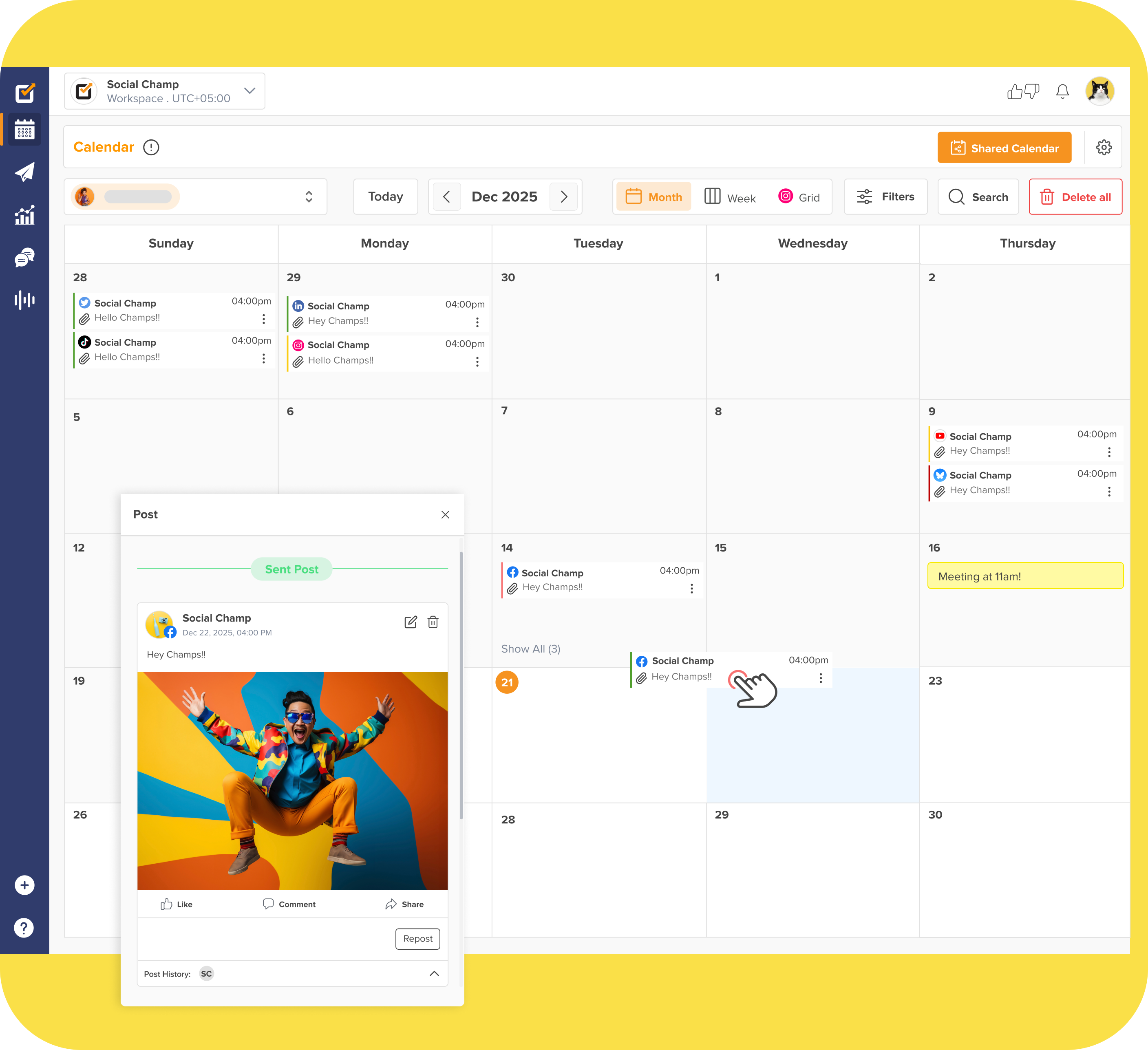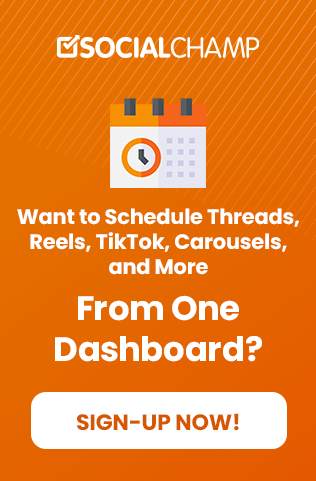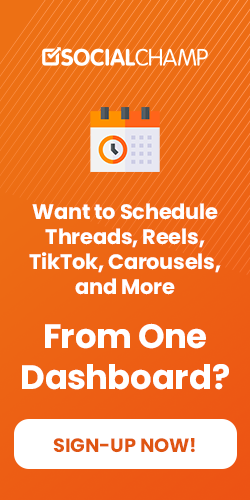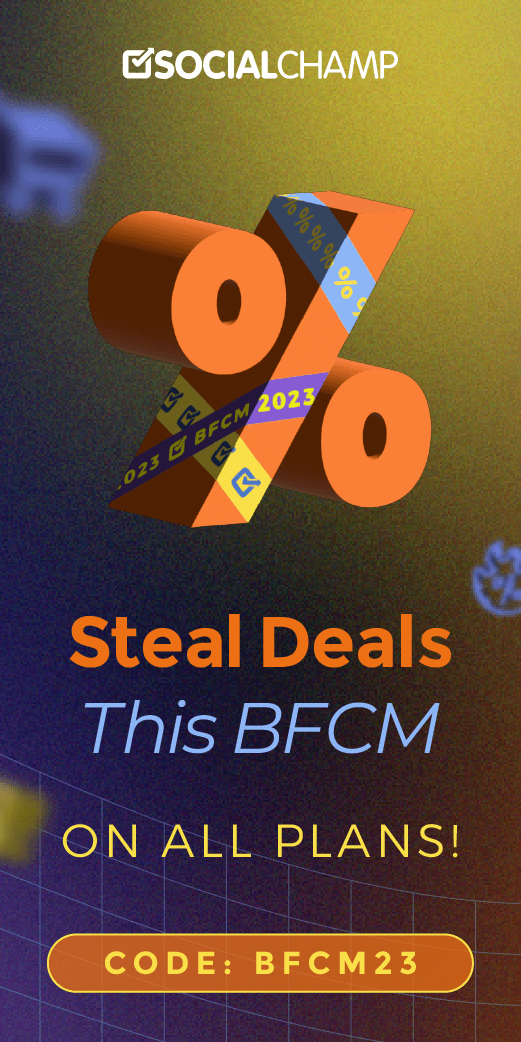You pick a product, choose a name, and go online. That’s exciting—until you realize no one’s buying.
For many new e-commerce owners, ‘marketing’ starts and ends with a post in their family WhatsApp group.
And when the sales don’t even hit the bare minimum, it’s tempting to say, “Maybe this just isn’t for me.”
But quitting isn’t the answer—powerful ecommerce marketing is. Today, there are approximately 30.7 million e-commerce websites worldwide.
That’s A LOT of competition.
So, if you want to dominate your niche, you need spot-on ecommerce marketing strategies—and a smart automation tool like Social Champ to maximize results.
In this blog, I’m going to cover some top ecommerce marketing secrets including 12 powerful tactics to help you turn clicks into conversions and scale your store faster.
Read on to find out!

Make Your Ecommerce Store the Next Hot Shopping Space!
From scheduling to analytics, Social Champ helps you streamline your marketing and sell smarter on social media. Start your free trial now!
Short Summary
- Ecommerce marketing is essential for driving traffic, increasing sales, and building brand awareness in the competitive online marketplace.
- A strong ecommerce marketing plan starts with defining your audience, identifying USPs, and maintaining a consistent brand identity.
- Effective strategies include SEO, PPC, social media, content marketing, influencer partnerships, affiliate marketing, and email campaigns.
- Retargeting, user-generated content, chatbot marketing, and collaborative marketing can significantly boost engagement and conversions.
- Social Champ streamlines ecommerce marketing by automating posts, tracking engagement, and optimizing strategies effortlessly.
- Future-proofing ecommerce requires leveraging AI, automation, and personalization while staying ahead of emerging trends.
- A well-executed ecommerce marketing strategy, backed by automation tools, ensures long-term growth and success.
- Understanding Ecommerce Marketing: A Beginner’s Guide
Ecommerce marketing isn’t just about setting up a store and hoping customers find you.
It’s a strategic approach to driving traffic, engaging potential buyers, and converting them into loyal customers.
Simply put, ecommerce marketing involves using online channels—like social media, search engines, email, and paid ads—to attract and retain shoppers.
But with competition at an all-time high, simply being online isn’t enough. You need a plan that covers the key growth levers that make a difference:
- SEO & Content Marketing– Optimized product descriptions, blogs, and landing pages help your store rank higher on search engines.
- Social Media & Influencer Marketing– Engaging posts, partnerships, and viral content keep your brand top-of-mind.
- Email & Retargeting– Personalized offers and abandoned cart emails bring back potential buyers.
- Paid Ads & Promotions– Facebook, Google, and TikTok ads help you target the right audience and boost sales.
Mastering these tactics ensures your ecommerce brand doesn’t just survive—but thrives in today’s saturated ecommerce industry.
Let’s discuss this in detail and discover how you can create a perfect ecommerce marketing plan to make the most of these growth levers.
Featured Article: How to Sell on Instagram in 2025 + 15 Instagram Shopping Tips
The Perfect Ecommerce Marketing Plan: How to Get Started
Follow these steps to get started on a perfect ecommerce marketing plan for your business.
-
First, You Need to Define Your Audience
Your marketing strategy is only as strong as your understanding of your audience.
Go too broad, and you’ll struggle to reach the right people. Go too niche, and your customer base might be too small.
Research demographics, interests, and shopping behaviors to identify your ideal buyers and tailor your messaging accordingly.
-
Define Your USPs
What sets your business apart?
Whether it’s competitive pricing, premium quality, unique product selection, or exceptional customer service, your Unique Selling Proposition (USP) should be clear.
Highlight these strengths in all your marketing efforts to give customers a reason to choose you over competitors.
-
Determine Your Brand Identity and Keep It Consistent
Your brand is more than just a logo—it’s the personality of your business.
Define your color scheme, typography, brand voice, and messaging style, and maintain consistency across your website, social media, ads, and packaging.
A strong, recognizable brand builds trust and customer loyalty.
-
Incorporate Must-Have Ecommerce Strategies Into Your Plan
A great ecommerce marketing plan goes beyond just running ads.
What you need is a good grasp of strategies involving digital marketing for ecommerce.
Leverage SEO, email marketing, influencer collaborations, retargeting, and social media campaigns to drive traffic and increase conversions.
Make sure your website is optimized for mobile users and provides a smooth shopping experience.
-
Allocate Your Marketing Budget Wisely
Spending without a strategy is a recipe for wasted resources. Determine how much to invest in paid ads, content marketing, social media, and email campaigns.
Prioritize channels that bring the highest ROI, for example, if you want to go for video marketing your ideal channel is YouTube, not Dailymotion.
In the end, always adjust your budget as you analyze performance.
-
Keep Tabs on Your Competitors
Your competitors—especially industry leaders—can provide valuable insights into market trends and successful strategies.
Monitor their product offerings, pricing, promotions, and customer engagement tactics. Learn from their successes and gaps to refine your approach.
-
Invest in a Marketing Automation Tool
Managing marketing manually can be overwhelming.
Tools like email automation, social media schedulers, and AI-powered chatbots can help streamline your efforts, nurture leads, and improve customer engagement—all while saving time.
A well-structured ecommerce marketing plan helps you attract, convert, and retain customers effectively. Start with these steps, track your progress, and refine your strategies for long-term success.
12 Must-Try Ecommerce Marketing Strategies for Rapid Growth
Ecommerce success isn’t just about listing products and hoping for sales. It’s about using the right marketing strategies to attract, engage, and convert your audience.
Here’s a breakdown of 12 powerful tactics that can fuel your store’s growth.
-
Social Media Marketing
Social media is one of the best ways to reach potential customers and keep your brand top-of-mind.
Platforms like Instagram, TikTok, and Facebook allow you to showcase products, interact with customers, and build a community around your brand.
Social commerce is also a good strategy to scale up your sales and attract more customers who just don’t like the hassle of browsing ecommerce websites.

Chewy’s Instagram Page The best way you can manage social media is via tools specifically built for it.
Social Champ, for instance, makes it simpler, easier, and way faster than hours of manual effort.
It automates your daily SMM tasks, pre-schedules posts across multiple channels, tracks analytics, and even allows social listening, providing you with a complete social media marketing and management package.

More Visibility, More Sales!
Schedule posts, analyze engagement, and stay ahead of trends with Social Champ’s AI-powered automation built for ecommerce success.
-
Content Marketing
A well-crafted content marketing strategy helps position your brand as an authority in your niche.
Blog posts, how-to guides, and infographics that educate and entertain your audience will not only attract potential customers but also improve your website’s SEO.
For example, a skincare brand could create blog posts about common skin concerns and recommend their products as part of the solution.
However content marketing is not just about blogs or guides, it also involves video marketing through channels like Instagram, TikTok, or YouTube, as well as podcasting to reach and engage your target market.

Sunflour’s Blog Page -
SEO Marketing
Search Engine Optimization (SEO) ensures that your store appears in search results when customers are looking for products like yours.
Start by optimizing your product descriptions with relevant keywords, improving your site speed, and ensuring your website is mobile-friendly.
A well-optimized store increases organic traffic, which means more potential customers without the ongoing costs of paid ads.

Top Stores on Google for Online Jewelry Store Keyword -
Influencer Marketing
Influencers have built trust with their followers, making their recommendations powerful.
If you don’t have the budget or resources to partner with a big name, consider working with micro-influencers—those with smaller but highly engaged audiences.
A fashion brand, for instance, could partner with a niche influencer to showcase outfits in a relatable way, driving real engagement and sales.

Post about Estee Lauder’s Collaboration -
Affiliate and Referral Marketing
Word-of-mouth marketing remains one of the most effective ways to gain new customers.
Affiliate marketing allows other content creators to promote your products in exchange for a commission.
Meanwhile, referral programs encourage existing customers to spread the word by offering discounts or rewards.
This not only increases brand awareness but also builds trust, since people are more likely to buy based on personal recommendations.

Estee Lauder Referral Program -
Paid Advertising (PPC & Social Ads)
Paid ads help you reach potential customers quickly, but they require a strategy to be effective
Platforms like Google Ads, Facebook, and Instagram allow you to target specific audiences based on their interests, behaviors, and demographics.
Retargeting ads are especially useful—if a visitor leaves your website without purchasing, you can remind them of the product they were interested in with an ad that appears on their social feed.

Shopify Ad on YouTube -
Email Campaigns
Email marketing is one of the highest ROI strategies in ecommerce because it keeps your audience engaged over time.
But blasting generic emails won’t work—personalization is key.
Segment your email list based on customer behavior and send tailored emails, such as abandoned cart reminders, exclusive discounts, and product recommendations based on past purchases.

Screenshot of Foodpanda Email -
Retargeting Strategies
Not every visitor will buy on their first visit, but that doesn’t mean they’re not interested.
Retargeting allows you to show ads to people who have already engaged with your store but didn’t make a purchase.
For example, if someone browsed a pair of shoes on your website but left without buying, you can use retargeting ads to remind them about that exact product and even offer a limited-time discount to encourage them to complete their purchase.

Example of Retargeting Ad -
UGC Marketing (User-Generated Content)
Consumers trust other consumers more than brands. Encourage your customers to share photos and videos of your products in action.
Feature these testimonials and real-life experiences on your website and social media to build credibility.
For example, if you sell fitness equipment, showcase videos of real customers using your gear and talking about their progress.

UGC Shared by Macy’s on Instagram -
Collaborative Marketing
Partnering with other brands can introduce your store to new audiences without the high costs of paid advertising.
Look for complementary brands rather than direct competitors.
A brand selling eco-friendly water bottles could collaborate with a company that sells sustainable backpacks, running a joint giveaway, or cross-promoting each other’s products to their respective audiences.

Glossier’s Collaboration With BarkBox to Create Dog Toys -
Chatbot Marketing
Customers expect quick responses, but hiring a full-time support team isn’t always feasible.
AI-powered chatbots can answer common questions, guide customers to the right products, and even assist with checkout—all in real time.
By integrating chatbots on your website and social media, you can improve customer experience and boost conversions, especially for shoppers who need quick information before making a purchase.
-
Use Both: E-commerce Platforms and Marketplaces
Ecommerce platforms and online marketplaces may seem similar, but they serve different purposes.
An ecommerce platform, like Shopify or WooCommerce, allows businesses to build and manage their own online store.
Whereas, marketplaces, like Amazon, eBay, and Etsy, are large platforms where multiple sellers list their products, extending their reach to an existing audience of ready-to-buy customers.
Smart ecommerce brands use both to maximize their reach.
Running an independent online store provides greater control over customer experience, marketing, and profit margins, but it can take time to attract traffic.
Selling on marketplaces, however, gives immediate exposure to a vast audience, increasing sales potential.
This digital marketing for ecommerce strategy balances control with exposure, maximizing reach and revenue.

Supergut’s Webstore
Bonus Tip: Analytics and Metrics Tracking
What gets measured gets improved.
Tracking key metrics—such as traffic sources, conversion rates, and customer acquisition costs—helps you identify what’s working and what’s not.
Use tools like Google Analytics or Social Champ’s analytics tool to understand how visitors interact with your store and make data-driven decisions to optimize your marketing efforts.

Featured Article: Social Media Audience Analysis: How to Understand and Engage Your Audience in 2025
How Social Champ Enhances Your Ecommerce Marketing Efforts
Managing ecommerce marketing across multiple platforms can be overwhelming, but Social Champ simplifies the process.
With powerful automation and scheduling tools, you can streamline your marketing efforts while staying consistent across social media.
- Automate Your Social Media– Schedule posts in advance, ensuring a steady flow of content without manual effort.
- Optimize for Maximum Engagement – Track performance with in-depth analytics and refine your strategy based on real-time insights.
- Manage All Platforms in One Dashboard – Save time by handling Facebook, Instagram, Twitter, LinkedIn, and more from a single interface.
- Boost Ecommerce Sales with Creative Content – Use Social Champ’s AI Suite to generate captions, graphics, and usernames.
- Unified Social Inbox for Faster Customer Support – Manage all social media messages, comments, and replies from one dashboard. No more switching between apps—respond faster and improve customer engagement.
- Social Media Bulk Uploading & Recycling – Upload and schedule hundreds of posts at once using bulk uploading. Evergreen content recycling ensures your top-performing posts continue to drive traffic.
Future-Proofing Your Ecommerce Strategy
The ecommerce industry is always changing, and businesses that fail to adapt risk losing their edge.
Future-proofing your strategy means building a business that can evolve with new trends, consumer expectations, and market shifts.
Instead of relying on short-term tactics, focus on scalable solutions that allow you to grow without constant reinvention.
Automation and AI help streamline operations, freeing up time to focus on strategy rather than repetitive tasks.
But future-proofing isn’t just about technology—it’s also about understanding customers.
Personalization, ethical sourcing, and seamless shopping experiences will continue to shape consumer choices.
Staying ahead means listening to your audience, keeping up with industry trends, and being flexible enough to redirect when needed.
Rather than chasing every new trend, invest in strategies that offer long-term stability—whether it’s optimizing your marketing, strengthening brand loyalty, or diversifying sales channels.
The brands that succeed are the ones that plan for the future, not just the present.

Sell More, Stress Less!
Simplify social media marketing with Social Champ’s AI-powered automation, in-depth analytics, and seamless post scheduling—all in one tool.
Conclusion
Success in ecommerce doesn’t happen by chance—it requires a strategic approach and the right mix of ecommerce marketing strategies to attract, engage, and convert customers.
The brands that win are the ones that adapt, experiment, and refine their approach based on what works.
The ecommerce landscape will continue to change, but the goal remains the same: reaching the right customers and turning them into loyal buyers.
As you implement smart, data-driven strategies and leverage tools like Social Champ, you can build a business that not only grows today but stays competitive in the future.













